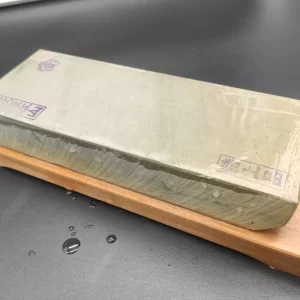Nakayama Kiita deserves its reputation as the best sharpening finishing stones money can buy. They're usually small, clean, fast, and good for everything from sharpening razors to polishing kitchen knives.
Beautiful, authentic kiita stone from the Nakayama mine. Mined in the 1950s. This stone is bright yellow in color, decorated with sparse nashiji dots and a couple of safe numazu lines.
The feel of the sharpening is divine, with a solid base and yet super smooth response. The black chip stands out instantly and the stone simply cuts through the steel while maintaining a wonderful tactile feel. Its suspension emits little, but this does not prevent it from working quickly.
Kasumi has a cloudy finish, with a high contrast between hagane and jigane, which is less common in the harder Nakayama stones. When working, the stone emits a strong and peculiar smell.
A horizontal plane shows a crack or loose rock around the entire stone about halfway through. Therefore, your grandchildren may have to remove several stones of about half a centimeter. There is also a small chance that the stone will split there. To reduce it, the sides of the stone can be coated with varnish, thus preventing water from entering the crack.
Nakayama (中山)
This Eastern mine is famous for its awasedo finishing stones, and is perhaps the most sought after among sharpening professionals and hobbyists. Compared to stones of similar hardness and fineness from other mines, Nakayama stones are known for a more pleasant sharpening response and high work speed. Multilayer stone (Hondomae, Shikitomae) and Kiita are especially valued.













Reviews
There are no reviews yet.